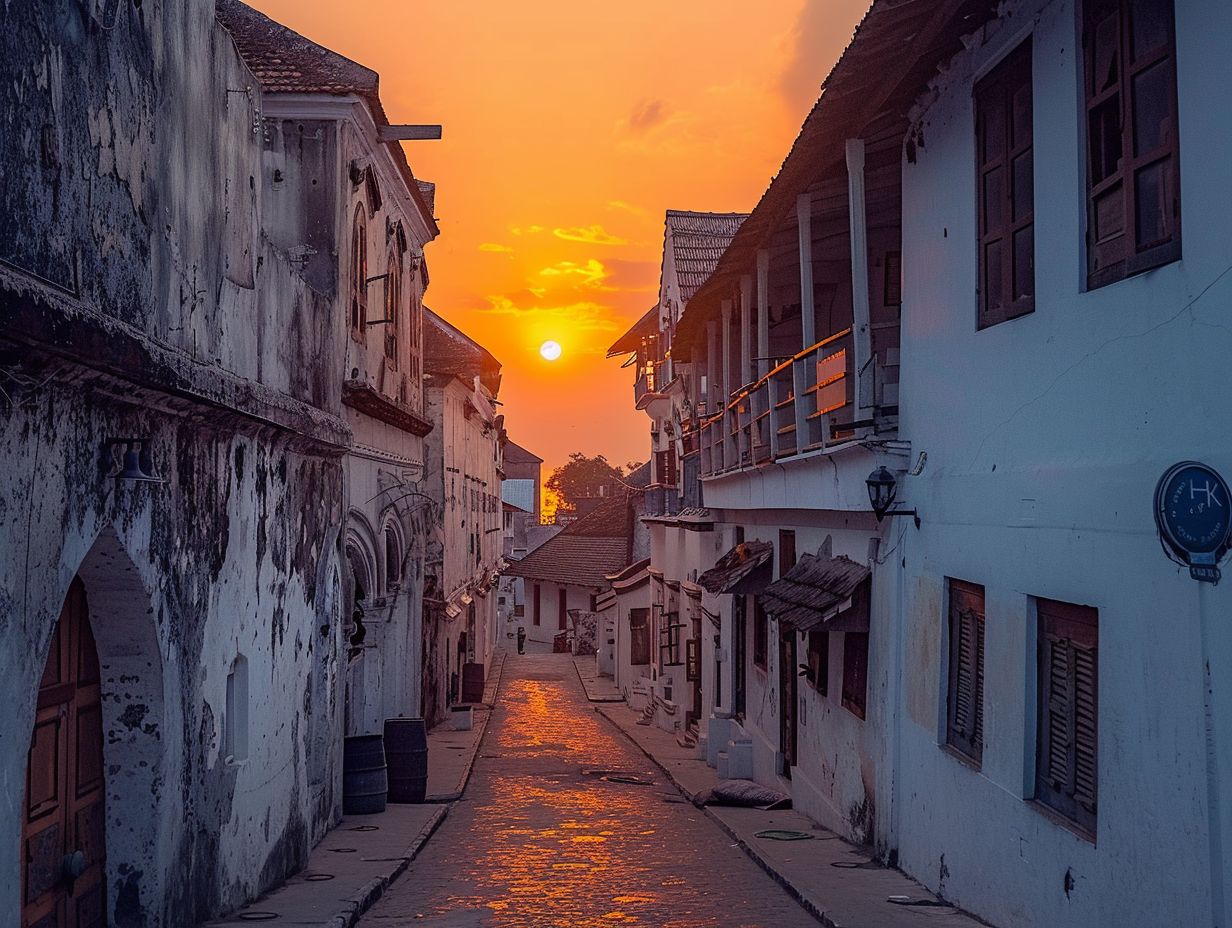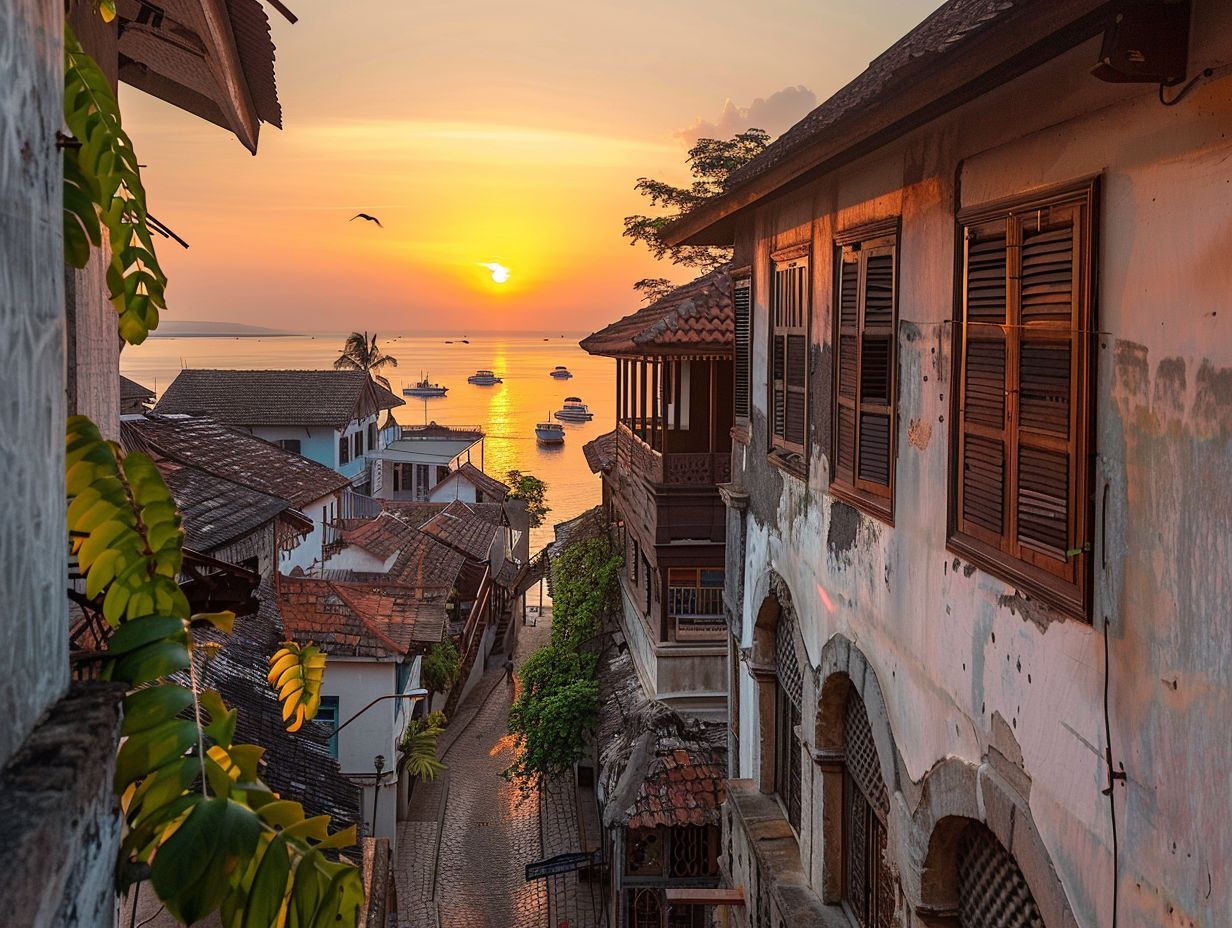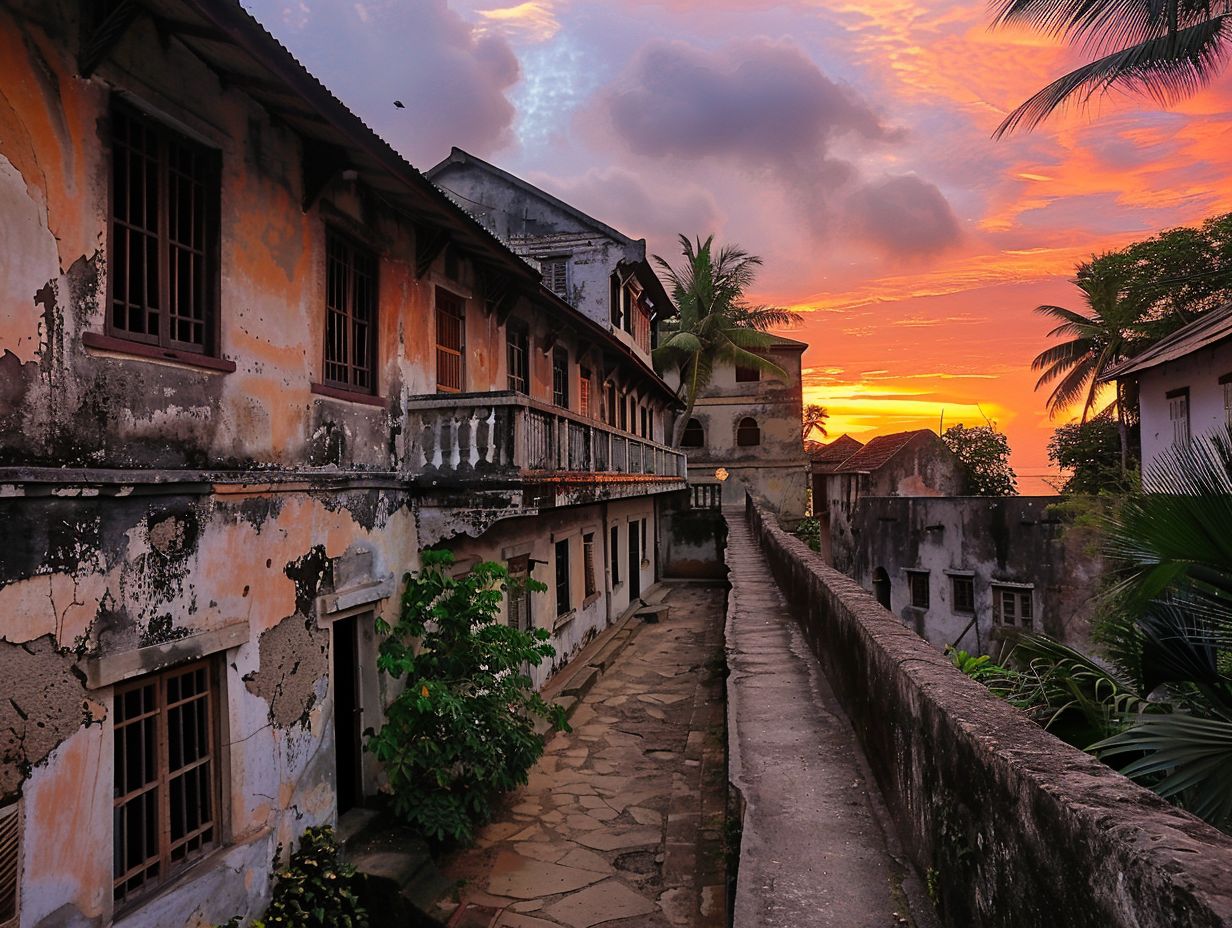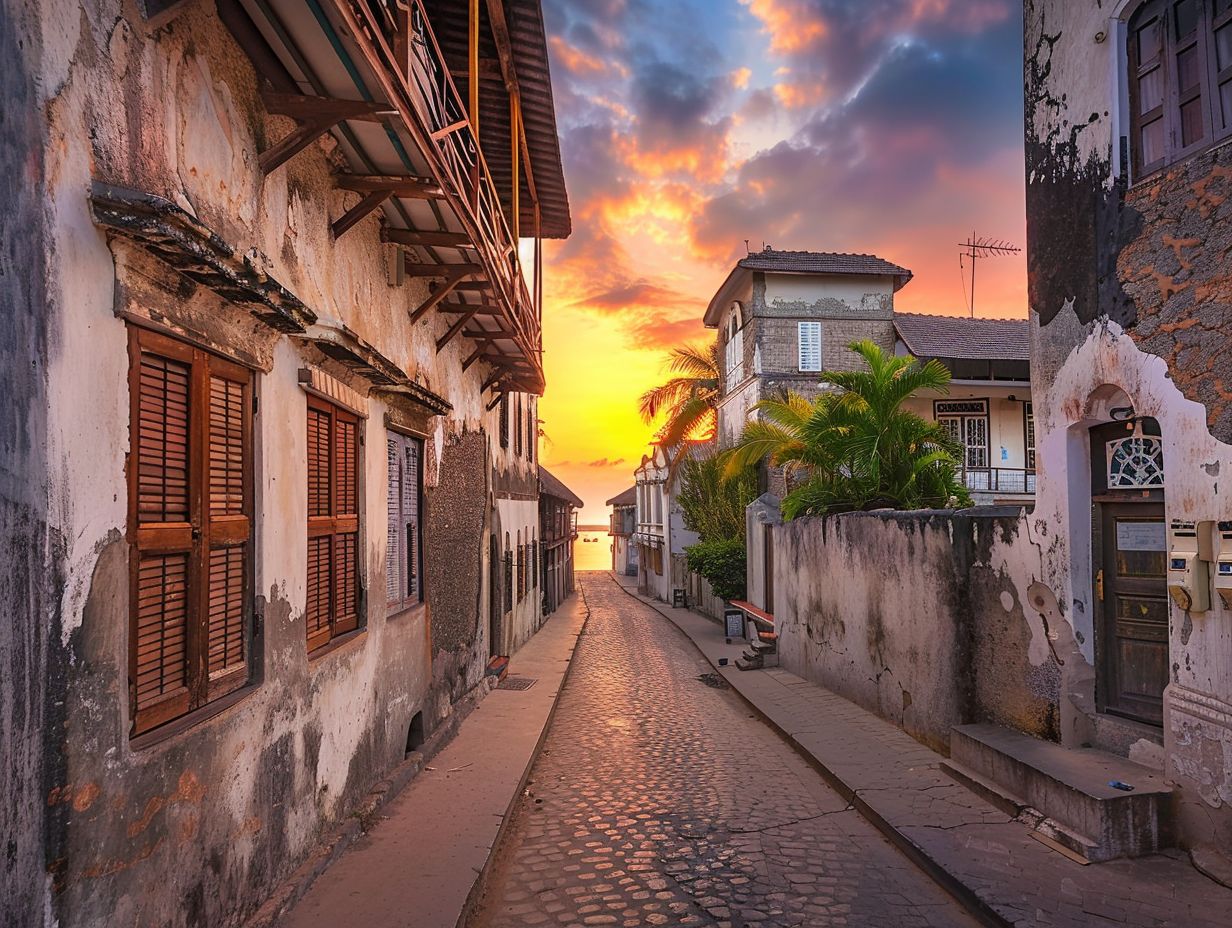
Stone Town Zanzibar
Welcome to the enchanting world of Stone Town Zanzibar, a place steeped in rich history, vibrant culture, and mouthwatering cuisine.
In this article, we will explore the origins and significance of Stone Town, along with how its traditions have evolved over time.
Discover the must-see attractions and best activities to do in this fascinating destination, as well as the traditional dishes that have shaped the local cuisine.
Whether you are looking for accommodations or seeking to immerse yourself in the local culture, Stone Town Zanzibar has something for everyone.
Join us on a journey through this captivating city and get ready to be swept away by its charm.
Key Takeaways:

- Experience the rich history of Stone Town Zanzibar, a UNESCO World Heritage Site, through its stunning architecture and cultural significance.
- Immerse yourself in the vibrant culture and traditions of Stone Town, from its diverse mix of influences to its evolving customs over time.
- Indulge in the delicious and unique flavors of Stone Town’s traditional dishes and cuisine, influenced by a fusion of cultures and spices.
What is Stone Town Zanzibar?
Stone Town Zanzibar, a UNESCO World Heritage Site, is a historic city located in Zanzibar known for its unique mixture of Arab, Indian, and European influences in architecture and culture.
With its origins dating back to the 19th century, Stone Town stands as a testament to the diverse history and legacy of Zanzibar. The intricate details of the buildings, characterized by ornate wooden doors and balconies, reflect the fusion of Swahili, Persian, and Indian design elements.
The winding alleys and bustling markets within Stone Town evoke a sense of timelessness, where history meets vibrant contemporary life. Strolling through its narrow streets, one can witness the harmonious coexistence of mosques, churches, and Hindu temples, highlighting Zanzibar’s religious diversity.
History of Stone Town Zanzibar:
The history of Stone Town Zanzibar is marked by the influence of various powers, from the Sultanate of Oman to the British Empire, and significant events like the Zanzibar Revolution led by the Arab-Shirazi Party.
During the 17th and 18th centuries, Zanzibar was under the control of the Sultanate of Oman, who played a significant role in shaping the island’s economy and culture. The Omani rule brought a flourishing slave trade and spice industry to Stone Town, leading to a diverse population mix of Arabs, Persians, Indians, and Africans.
In the late 19th century, Zanzibar became a British protectorate after the signing of treaties to end the slave trade. This colonial era saw the implementation of new administrative structures and the establishment of British dominance over the region.
-
What is the Origin of Stone Town Zanzibar?
Stone Town Zanzibar’s origin can be traced back to the development of historical buildings, reflecting the architectural styles influenced by Arab, Indian, and European cultures.
These diverse cultural influences have significantly shaped the urban fabric of Stone Town, creating a unique blend of design elements and construction techniques. The narrow winding streets, intricately carved wooden doors, and courtyard layouts showcase the fusion of Swahili, Islamic, and colonial influences.
- The use of coral rag and lime mortar, characteristic of Swahili architecture, is evident in many buildings, providing both structural stability and aesthetic appeal.
- The ornate balconies and verandas, reflecting Indian influences, add a touch of elegance to the buildings, while the large windows and high ceilings, typical of European architecture, allow for natural light and ventilation.
This harmonious integration of architectural styles not only reflects the rich history of the region but also serves as a testament to the cultural exchange and trade that have long been central to Zanzibar’s identity.
-
What is the Significance of Stone Town Zanzibar?
Stone Town Zanzibar holds immense significance due to its rich cultural heritage, influenced by the history of the slave trade and the diverse cultural fusion of Arab, Indian, and European elements.
Located on the picturesque island of Zanzibar, Stone Town stands as a testament to the historical complexities and the resilient spirit of cultural preservation. The remnants of the slave trade era intertwine with the ornate architecture, narrow alleyways, and bustling markets, creating a unique blend of past and present. The conservation efforts in Stone
Town are crucial in safeguarding its heritage buildings, such as the Old Fort and the Sultan’s Palace, preserving them for future generations to appreciate.
Culture and Traditions of Stone Town Zanzibar:
The culture and traditions of Stone Town Zanzibar are a vibrant tapestry of Swahili heritage interwoven with Persian and Indian elements, creating a unique cultural fusion.
Swahili culture is deeply rooted in the history and lifestyle of the locals, influencing everything from music and dance to cuisine and architecture. Persian influences can be seen in the intricate wood carvings and the design of old merchant houses, while Indian heritage has left its mark in the spices used in local dishes and the bustling markets.
The evolution of cultural practices over time has resulted in a dynamic blend of traditions that reflects the diverse influences that have shaped Stone Town. The vibrant colors of the local fabrics, the lively rhythms of traditional music, and the warm hospitality of the people all contribute to the rich tapestry of cultural experiences in this historic town.
-
What are the Main Cultures and Traditions in Stone Town Zanzibar?

The main cultures and traditions in Stone Town Zanzibar revolve around the fusion of various cultural elements, reflected in the distinctive use of coral stone in architecture and the incorporation of diverse cultural practices.
Stone Town in Zanzibar is a fascinating blend of Swahili, Indian, Arab, and European influences, creating a unique tapestry of cultural diversity. The utilization of coral stone in buildings not only adds to the town’s charm but also showcases the intricate craftsmanship of local artisans.
Traditional practices like the Swahili architecture and the art of henna painting reflect the rich heritage of the region. The narrow winding streets and intricately carved wooden doors narrate stories of the past, inviting visitors to delve into the historical significance of this UNESCO World Heritage Site.
-
How Have These Cultures and Traditions Evolved Over Time?
The cultures and traditions in Stone Town Zanzibar have evolved over time, shaping the urban fabric and architectural aesthetics, exemplified by the intricate designs of wooden doors that reflect the historical influences.
Stone Town, with its labyrinthine alleys and maze-like streets, is a living testament to the harmonious blend of Swahili, Arab, Persian, Indian, and European cultures that have left indelible marks on its landscape.
Urban heritage in Zanzibar is not just about physical structures but also encompasses intangible aspects such as music, language, and cuisine. The architectural evolution in Stone Town tells a story of trade, conquests, and cultural exchange, where each wooden door is a portal to a bygone era, adorned with intricate carvings and brass studs that signify prosperity and status.
Attractions in Stone Town Zanzibar:

Stone Town Zanzibar offers a plethora of attractions, from the vibrant Forodhani Garden Markets to the mesmerizing historical buildings that showcase the city’s rich heritage and architectural beauty.
Walking through the narrow winding streets of Stone Town, visitors can admire the intricate designs of buildings like the House of Wonders, the Old Fort, and the Sultan’s Palace.
These structures not only serve as stunning landmarks but also play a crucial role in preserving the city’s cultural legacy. The blend of Swahili, Arab, Persian, Indian, and European influences in architecture reflects the diverse history and influences that have shaped Zanzibar over the centuries. The UNESCO-listed Stone Town stands as a living testament to a bygone era where history and culture intertwine seamlessly.
-
What are the Must-See Places in Stone Town Zanzibar?
Some of the must-see places in Stone Town Zanzibar include the Department of Museums and Antiquity, where visitors can delve into the rich Swahili culture and explore historical artifacts.
Aside from the Department of Museums and Antiquity, visitors to Stone Town Zanzibar are captivated by the iconic House of Wonders, a grand palace that showcases the opulence of the 19th-century Omani Sultans. Strolling through the narrow streets, one can marvel at the Old Fort, a historic structure that has witnessed centuries of history.
The bustling Forodhani Market beckons with its array of spices, local crafts, and delectable street food, giving a true taste of Zanzibar’s vibrant culture.
-
What are the Best Activities to Do in Stone Town Zanzibar?
Engaging in activities that promote urban heritage and conservation efforts in Stone Town Zanzibar can offer visitors a deeper understanding of the city’s historical significance and architectural charm.
Exploring the narrow winding streets lined with intricately carved doors, faded colonial buildings, and bustling markets can transport individuals back in time, allowing them to connect with the diverse cultural influences that have shaped Stone Town over the centuries.
Visiting iconic landmarks like the House of Wonders or the Old Fort provides insights into Zanzibar’s rich history and the importance of preserving these gems for future generations to appreciate.
Food and Cuisine in Stone Town Zanzibar:
The food and cuisine in Stone Town Zanzibar are a delightful reflection of its history, with influences from the British protectorate era and a rich array of spices that enhance the flavors of local dishes.
British influence is evident in some classic dishes like ‘Zanzibar Mix’, a fusion of chapati, bhajias, and mshikaki reflecting a blend of cultures. The incorporation of spices, a legacy of the island’s past as a major spice-trading hub, infuses dishes with layers of flavor.
Cardamom, cloves, cinnamon, and nutmeg are staples, reflecting Zanzibar’s aromatic heritage. The history of Zanzibar is intertwined with the evolution of its culinary traditions, creating a unique gastronomic experience that tells a story of trade, colonization, and cultural exchange.
-
What are the Traditional Dishes in Stone Town Zanzibar?

Traditional dishes in Stone Town Zanzibar, inspired by historical figures like Sultan Majid bin Said, offer a delightful culinary journey through the flavors of Swahili cuisine and local specialties.
One of the standout dishes that embodies this fusion of flavors is Urojo, a spicy soup packed with tropical ingredients like mango, tamarind, and coconut milk.
Another must-try delicacy is Zanzibar Mix, a platter of tasty snacks including fried cassava, plantains, and crispy samosas.
The culinary heritage of this ancient spice hub echoes in dishes like Pilau, a fragrant rice dish infused with cloves, cardamom, and cinnamon.
-
What Influences Have Shaped the Local Cuisine in Stone Town Zanzibar?
The local cuisine in Stone Town Zanzibar has been shaped by diverse influences, including Indian culinary traditions and the cultural symbolism represented in the intricate designs of wooden doors found throughout the city.
Indian culinary traditions have played a significant role in shaping the flavors and spices that define the cuisine of Stone Town, creating a unique fusion of tastes that reflect the region’s historical connections with the Indian subcontinent. The use of aromatic spices like cumin, cardamom, and turmeric adds depth and richness to local dishes, infusing them with a burst of flavor.
The wooden doors, adorned with intricate carvings and brass studs, not only serve as architectural marvels but also symbolize the diverse cultural heritage that defines Stone Town. These doors, inspired by Swahili, Arab, Indian, and European design elements, stand as a testament to the city’s history of trade and cultural exchange.
Accommodations in Stone Town Zanzibar:
Accommodations in Stone Town Zanzibar cater to diverse preferences, with options ranging from historic establishments to modern facilities, ensuring a comfortable stay for visitors exploring the city’s vibrant neighborhoods.
For those seeking a touch of history, charming boutique hotels housed in restored colonial buildings offer a unique experience, blending tradition with comfort. On the other hand, sleek and contemporary hotels provide state-of-the-art amenities for travelers looking for a more modern stay. Guesthouses and bed-and-breakfasts dotted throughout the city give a glimpse into the local way of life, offering a more intimate setting perfect for those wanting an authentic Zanzibari experience.
-
What are the Best Places to Stay in Stone Town Zanzibar?
Opting for the best places to stay in Stone Town Zanzibar, such as accommodations with historical ties to the British Empire or those situated near the bustling Darajani Market, can enhance the overall experience of visitors exploring the city.
One such remarkable lodging option is the luxurious Park Hyatt Zanzibar, exuding a perfect blend of modern comfort and historical charm with its 17th-century architecture. Guests can immerse themselves in the rich cultural heritage while being steps away from iconic landmarks like the House of Wonders and Forodhani Gardens.
Alternatively, the Emerson on Hurumzi Hotel, housed in a restored palace, offers a glimpse into Zanzibar’s Swahili past. Its rooftop terrace provides panoramic views, making it an ideal spot to soak in the vibrant atmosphere of Stone Town.
-
What Types of Accommodations are Available in Stone Town Zanzibar?
A diverse range of accommodations awaits visitors in Stone Town Zanzibar, blending cultural fusion elements from Arab, Persian, and Indian traditions to offer a unique and immersive stay experience reflective of the city’s rich heritage.
- Traditional Swahili-style guesthouses with intricately carved wooden doors and vibrant local fabrics provide a glimpse into the region’s historical architecture.
- Luxury boutique hotels combine modern amenities with Swahili design motifs, showcasing ornate brass lanterns and hand-carved furniture.
- Quaint bed and breakfasts offer a cozy retreat, adorned with colorful Zanzibari textiles and showcasing traditional handicrafts.
Frequently Asked Questions:
1. What is Stone Town Zanzibar?
A: Stone Town Zanzibar is a historic town located on the island of Zanzibar, off the coast of Tanzania in East Africa. It is known for its unique blend of African, Arab, Indian, and European influences and its well-preserved architecture.
2. What are the must-see attractions in Stone Town Zanzibar?
A: Some of the must-see attractions in Stone Town Zanzibar include the Old Fort, the House of Wonders, the Palace Museum, the Forodhani Gardens, and the narrow alleyways and bustling markets of the town’s historic center.
3. Is Stone Town Zanzibar safe for tourists?
A: Stone Town Zanzibar is generally considered safe for tourists, but it is always wise to take precautions and be aware of your surroundings. Avoid walking alone at night and be wary of pickpockets in crowded areas.
4. What is the best time to visit Stone Town Zanzibar?
A: The best time to visit Stone Town Zanzibar is during the dry season, from June to October, when the weather is pleasant and there is little chance of rain. However, the town can be visited year-round.
5. What is the currency used in Stone Town Zanzibar?
A: The local currency used in Stone Town Zanzibar is the Tanzanian shilling. However, US dollars and Euros are also widely accepted in most tourist areas. It is recommended to exchange currency at banks or official exchange bureaus.
6. What can I buy in Stone Town Zanzibar?
A: Stone Town Zanzibar is a great place to shop for unique souvenirs and gifts. Popular items include traditional spices, handcrafted wood carvings, colorful fabrics, and beautiful jewelry made from locally sourced gemstones.